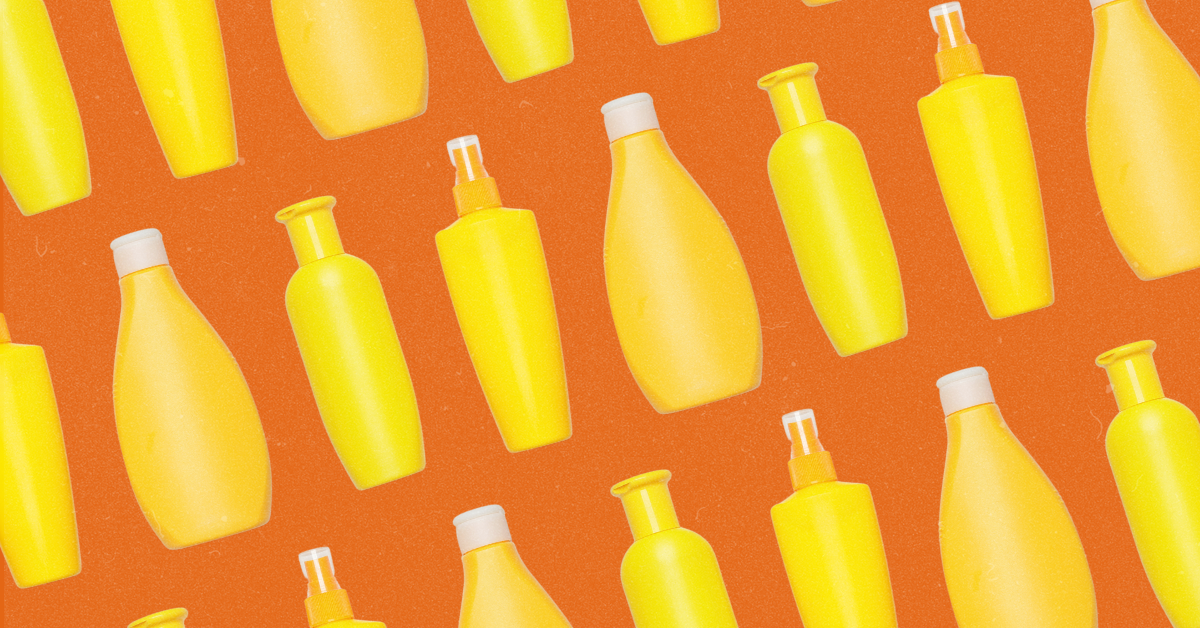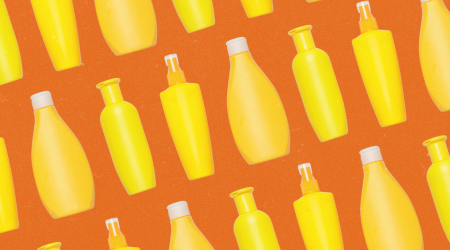
Face it: sometimes, you’re just too busy to pay attention to your skin. What’s a harried person to do, when skin-care routines touted online often have 10+ steps?
We went straight to the source—five dermatologists—for their desert-island tip: the one thing you absolutely must do every day for your skin. The answer was unanimous.
1. Always apply sunscreen
Everyone agreed: The No. 1 thing you can do to take care of your skin is apply sunscreen daily.
[time-brightcove not-tgx=”true”]“Applying sunscreen every day is the most important thing you can do to keep your skin looking healthy and prevent skin cancer,” says Dr. Sara Perkins, assistant professor of dermatology at the Yale School of Medicine. “Ultraviolet radiation can lead to hyperpigmentation, fine lines, and wrinkles, not to mention basal and squamous cell skin cancer and melanoma.”
Sunscreen is a no-brainer if you work outdoors or live in a warm, sunny city. But even if you spend most of your time indoors or live somewhere that’s often overcast, it’s still important. “I think most people underestimate the amount of sun exposure they get each day through [things like] windows, running errands, walking the dog, and playing tennis,” she says. “We’re also still getting exposure on cloudy days and in colder temperatures.”
Apply sunscreen of at least 30 SPF to your face, neck, and any area of your skin that’s exposed to the sun, including places you wouldn’t normally consider, like your ears and the backs of your hands, says Dr. Rosanne Paul, assistant professor of dermatology at Case Western Reserve University in Cleveland. She adds that most people underestimate the amount of sunscreen they need—in general, the amount you’d fit on your fingertip is the amount you should use to cover the surface area of your palm. (Your face is probably the size of two to three palms, so you’d need two to three fingertip’s worth of sunscreen.) Another way of looking at it, she says, is that a shot glass full of sunscreen would typically be the right amount if you’re outside in a bathing suit.
Read More: What’s the Best Skin-Care Routine?
There are both mineral and chemical sunscreens. Mineral sunscreens (which contain ingredients like zinc and titanium) create a barrier between the skin and the sun, bouncing UV light off of the skin. Chemical sunscreens (which include ingredients like avobenzone) absorb it like a sponge, says Dr. Heather Goff, director of cosmetic dermatology and associate professor of dermatology at UT Southwestern Medical Center in Dallas. Both are effective, but most experts recommend mineral-based sunscreens since they’re gentler on the skin, especially for people with conditions like rosacea and eczema. (Plus, chemical sunscreens can be harmful to the ocean’s coral reefs.) Goff adds that you should select a sunscreen that says broad-spectrum, as this means it protects against both UVA and UVB rays.
Some research suggests the blue light that’s emitted from our screens can cause hyperpigmentation of the skin. If you have a lot of dark spots or you spend a lot of time in front of screens, consider using a tinted sunscreen, Paul says, as the ferric oxide in tinted sunscreen is protective against hyperpigmentation, as well as the visible light emitted from our screens.
Though sunscreen took the top spot, the dermatologists also offered four more skin-care priorities.
2. Use a retinoid or retinol
The next-most popular piece of advice was to use a topical retinoid. Retinoids, which are a derivative of vitamin A, can promote skin cell turnover; improve pigmentation; minimize the clogging of pores; and stimulate the production of collagen and elastin, which can help reduce the appearance of fine lines and wrinkles, Perkins says. “Their efficacy is well-supported by decades of research, so if you’re looking for something that will deliver real results, this is it,” she says.
Topical retinoids (like tretinoin) are prescription medications, whereas retinol is a type of retinoid that’s available over the counter. Prescription retinoids are already in their active form, whereas retinol has to be converted by the body into the active form, says Dr. Alexis Livingston Young, a dermatologist at Hackensack University Medical Center. While all retinoids are effective, prescription retinoids are generally thought to be more effective than retinol since they’re stronger, Young says. She adds that this area is a bit murky since over-the-counter retinol products aren’t regulated by the U.S. Food and Drug Administration (FDA).
Young recommends people begin using a retinoid after age 25 or 30. Retinoids can have side effects like redness, dryness, irritation, and peeling, so she suggests people with sensitive skin start with retinol. And, of course, people using retinoids should always wear sunscreen since these drugs make the skin more sensitive.
3. Add a topical antioxidant to your routine
One great way people can take care of their skin is by using a topical antioxidant every day, Paul says.
Topical antioxidants can help protect against the damage caused by free radicals, which are harmful molecules that are generated by the sun’s UV rays. Free radicals can damage DNA, which can lead to skin cancer and other skin conditions, as well as fine lines and wrinkles. Retinol is a type of antioxidant, but there are several others with notable benefits.
Topical antioxidants are available over the counter, and most come in serum form. Paul recommends using a vitamin C serum, especially if you’re looking to manage fine lines, wrinkles, or pigmented spots.
Read More: 8 Eating Habits That Actually Improve Your Sleep
She notes that while there are some very costly vitamin C serums on the market, “you don’t have to buy an extremely expensive one in order for it to be effective.”
Paul recommends people add antioxidants to their skin care routine in their late 20s or early 30s. Be sure to use an antioxidant product consistently for two to three months before giving up, she says, as it can take this long to see results.
4. The lifestyle things: Hydrate, get enough sleep, and eat a balanced diet
By focusing on your gut health, you can improve your skin health, says Dr. Deeptej Singh, assistant professor of dermatology at the University of New Mexico and founder of Sandia Dermatology.
Many skin care products include antioxidants like niacinamide, vitamin A, vitamin C, vitamin B, and potassium. Including these in your diet—as opposed to just using them topically—can be an effective way to take care of your skin health, Singh says. He recommends a diet that focuses on whole plant foods like fruits, vegetables, nuts, seeds, legumes, beans, and intact grains.
Read More: 8 Ways to Stay Hydrated if You Hate Drinking Water
And don’t forget to drink enough H20. “Water is a phenomenally healthful beverage, and so are tea and coffee,” he says. People often worry about drinking too much caffeine, but caffeine can actually be good for the skin, he says, noting that many skin care products are purposefully formulated with caffeine in them.
Just make sure you aren’t using caffeine to make up for lost sleep: “Sleep is integral for skin health,” he says. “Sleep is the time when we detoxify and repair our body, and if you’re trying to use caffeine as a crutch to make up for lack of sleep, you’re not going to get the benefit of it, and you’re going to notice the imbalance in your skin.”
Try to stay away from that nightly glass of wine, too, as alcohol can have a negative effect on the skin. “The fermentation of alcohol causes a reaction in the gut, which can kind of overwhelm our detoxifying capacity and lead to inflammation in the skin,” Singh says.
5. Consider using a red-light therapy mask
Red-light therapy masks, which have become increasingly popular in recent years, can be a great addition to someone’s daily skin care routine, Singh says. They can stimulate collagen production and protect against fine lines and wrinkles, he says. (They’re also quite expensive, with most costing several hundred dollars.)
But how exactly do they work? Sunlight is composed of near-infrared light (which is invisible and accounts for 50% of sunlight); visible light (which includes red light); and ultraviolet light. Both red light and near infrared light “directly communicate with our cellular mitochondria, or the energy powerhouses of the cells, and it activates them,” Singh says. “It keeps them young.”
Red-light therapy masks can mimic this naturally occurring process. Although red light therapy masks are a new trend, Singh notes that different forms of light therapy have been used to treat and prevent skin diseases for over a century.
Singh recommends using a red light therapy mask at least three times a week to see results, though it’s safe to use daily. As long as you—you guessed it—always wear sunscreen.




























